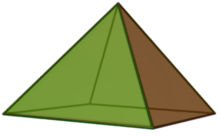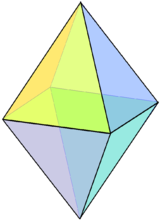Square pyramid
| Square pyramid | |
|---|---|
 | |
| Type | Johnson J92 – J1 – J2 |
| Faces | 4 congruent triangles 1 square |
| Edges | 8 |
| Vertices | 5 |
| Vertex configuration | 4 (32.4) (34) |
| Schläfli symbol | ( ) ∨ {4} |
| Symmetry group | C4v, [4], (*44) |
| Rotation group | C4, [4]+, (44) |
| Volume | V = (l2.h)/3 |
| Dual polyhedron | self |
| Properties | convex |
| Net | |
 | |

In geometry, a square pyramid is a pyramid having a square base. If the apex is perpendicularly above the center of the square, it is a right square pyramid, and has C4v symmetry. If all edge lengths are equal, it is an equilateral square pyramid,[1] the Johnson solid J1.
General square pyramid[]
A possibly oblique square pyramid with base length l and perpendicular height h has volume:
- .
Right square pyramid[]
In a right square pyramid, all the lateral edges have the same length, and the sides other than the base are congruent isosceles triangles.
A right square pyramid with base length l and height h has surface area and volume:
- ,
- .
The lateral edge length is:
- ;
the slant height is:
- .
The dihedral angles are:
- between the base and a side:
- ;
- between two sides:
- .
Equilateral square pyramid, Johnson solid J1 []
If all edges have the same length, then the sides are equilateral triangles, and the pyramid is an equilateral square pyramid, Johnson solid J1.
The Johnson square pyramid can be characterized by a single edge length parameter l.
The height h (from the midpoint of the square to the apex), the surface area A (including all five faces), and the volume V of an equilateral square pyramid are:
- ,
- ,
- .
The dihedral angles of an equilateral square pyramid are:
- between the base and a side:
- .
- between two (adjacent) sides:
- .
Graph[]
A square pyramid can be represented by the wheel graph W5.
Related polyhedra and honeycombs[]
| Regular pyramids | ||||||||
|---|---|---|---|---|---|---|---|---|
| Digonal | Triangular | Square | Pentagonal | Hexagonal | Heptagonal | Octagonal | Enneagonal | Decagonal... |
| Improper | Regular | Equilateral | Isosceles | |||||

|

|

|

| |||||

|

|

|

|

|

|

|

| |

|

|

|
|---|---|---|
| A regular octahedron can be considered a square bipyramid, i.e. two Johnson square pyramids connected base-to-base. | The tetrakis hexahedron can be constructed from a cube with short square pyramids added to each face. | Square frustum is a square pyramid with the apex truncated. |
Square pyramids fill space with tetrahedra, truncated cubes, or cuboctahedra.[2]
Dual polyhedron[]
The square pyramid is topologically a self-dual polyhedron. The dual's edge lengths are different due to the polar reciprocation.
| Dual of square pyramid | Net of dual |
|---|---|

|

|
References[]
- ^ Franz Hocevar, Solid Geometry, 1903, p. 44
- ^ 凸正多角面体充填一覧表 / List of Regular polygon faced convex honeycomb
External links[]
- Eric W. Weisstein, Square pyramid (Johnson solid) at MathWorld.
- Weisstein, Eric W. "Wheel graph". MathWorld.
- Square Pyramid -- Interactive Polyhedron Model
- Virtual Reality Polyhedra georgehart.com: The Encyclopedia of Polyhedra (VRML model)
- Johnson solids
- Prismatoid polyhedra
- Pyramids and bipyramids
- Self-dual polyhedra










